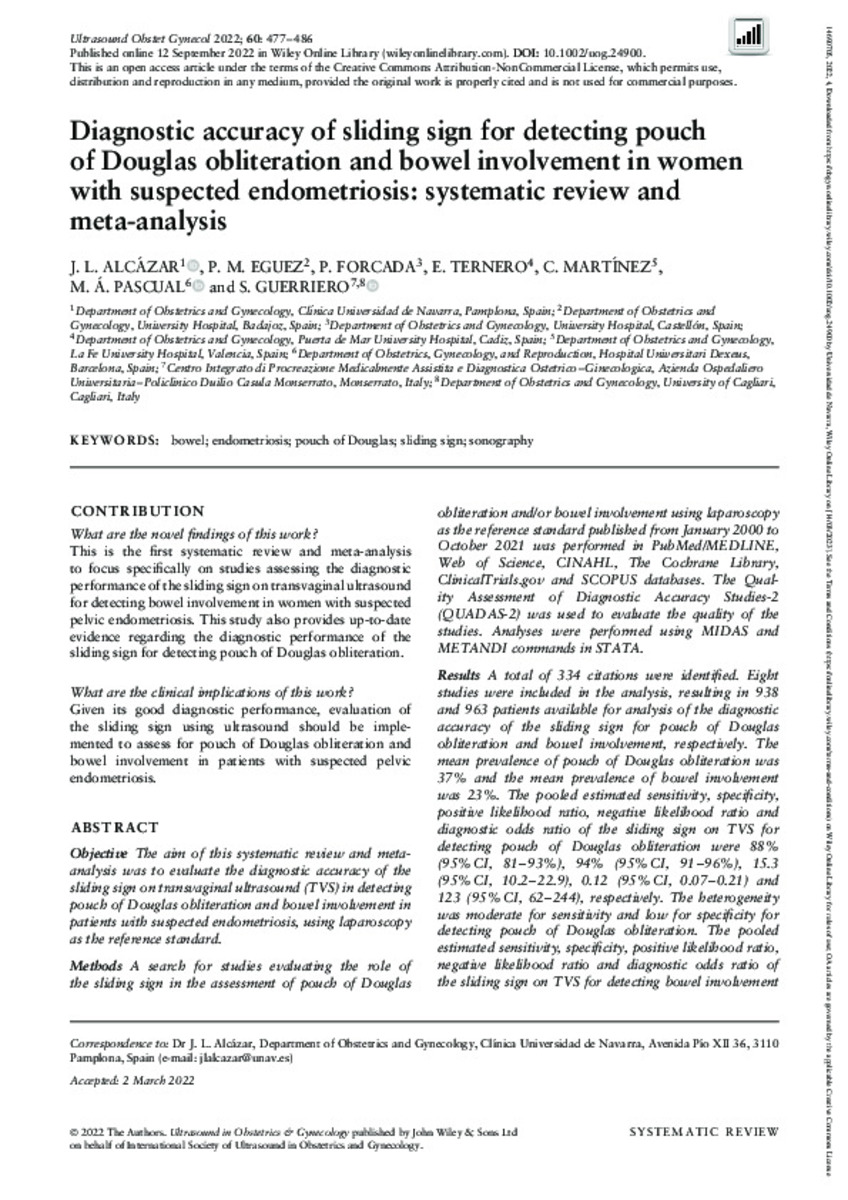Objetivo. El objetivo de esta revisión sistemática y metaanálisis fue evaluar la precisión diagnóstica del signo deslizante en la ecografía transvaginal (ETV) para detectar la obliteración del fondo de saco de Douglas y la afectación intestinal en pacientes con sospecha de endometriosis, utilizando la laparoscopia como estándar de referencia. Métodos. Se realizó una búsqueda de estudios que hubieran evaluado la función del signo deslizante en la valoración de la obliteración del fondo de saco de Douglas y/o la afectación intestinal utilizando la laparoscopia como estándar de referencia, publicados desde enero de 2000 hasta octubre de 2021 en las bases de datos PubMed/MEDLINE, Webof Science, CINAHL, The Cochrane Library, ClinicalTrials.gov y SCOPUS. Para evaluar la calidad de los estudios se utilizó la herramienta de Evaluación de Calidad de los Estudios de Precisión Diagnóstica-2 (QUADAS-2, por sus siglas en inglés) Los análisis se realizaron mediante los comandos MIDAS y METANDI de STATA. Resultados .Se identificaron un total de 334 citas. En el análisis se incluyeron ocho estudios, lo que dio como resultado938 y 963 pacientes disponibles para el análisis de la precisión diagnóstica del signo deslizante para la obliteración del fondo de saco de Douglas y la afectación intestinal, respectivamente. La prevalencia media de la obliteración del fondo de saco de Douglas fue del 37% y la prevalencia media de la afectación intestinal fue del 23%. La estimación combinada de la sensibilidad, especificidad, cociente de verosimilitud positivo, cociente de verosimilitud negativo y razón de momios del diagnóstico del signo deslizante en la ETV para detectar la obliteración del fondo de saco de Douglas fue del 88% (IC 95%, 81 – 93%), 94% (IC 95%, 91 – 96%), 15,3 (IC 95%, 10,2 – 22,9), 0,12 (IC 95%, 0,07 – 0,21)y 123 (IC 95%, 62 – 244), respectivamente. La heterogeneidad fue moderada en cuanto a la sensibilidad y baja en cuanto a la especificidad para detectar la obliteración del fondo de saco de Douglas. La estimación combinada de la sensibilidad, especificidad, cociente de verosimilitud positivo, cociente de verosimilitud negativo y razón de momios del diagnóstico del signo deslizante en la ETV para detectar la afectación intestinal fue del 81% (IC 95%, 64 – 91%), 95%(IC 95%, 91 – 97%), 16,0 (IC 95%, 9,0 – 28,6), 0,20 (IC 95%, 0,10 – 0,40) y 81 (IC 95%, 34 – 191), respectivamente .La heterogeneidad del meta análisis de la precisión diagnóstica de la afectación intestinal fue alta. Conclusiones. El signo deslizante en la ETV tiene un buen rendimiento diagnóstico para predecir la obliteración del fondo de saco de Douglas y la afectación intestinal en mujeres con sospecha de endometriosis.©2022 The Authors. Ultrasound in Obstetrics & Gynecology published by John Wiley & Sons LtdSYSTEMATIC REVIEW on behalf of International Society of Ultrasound in Obstetrics and Gynecology.







